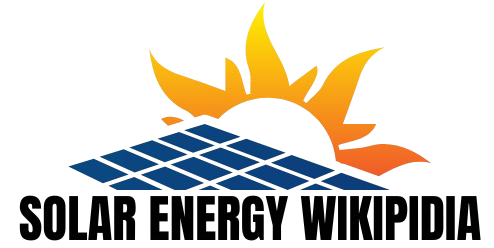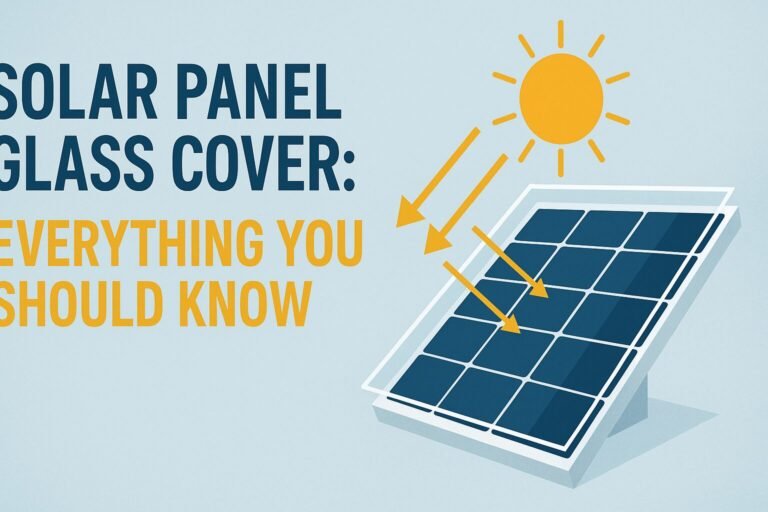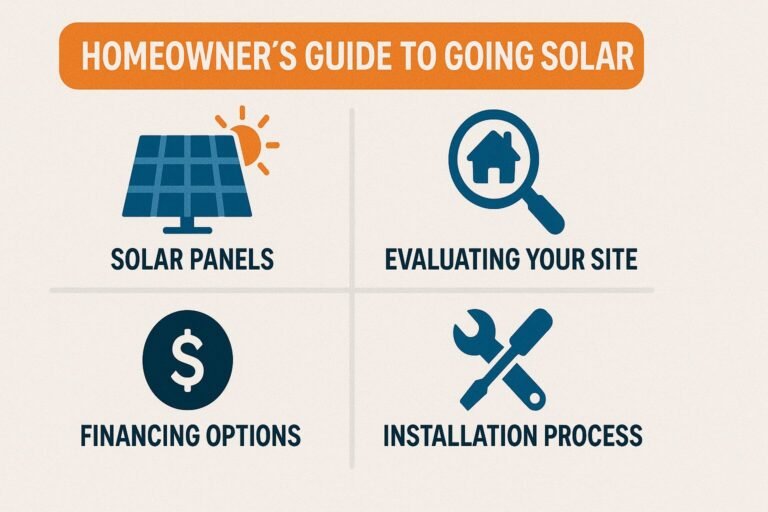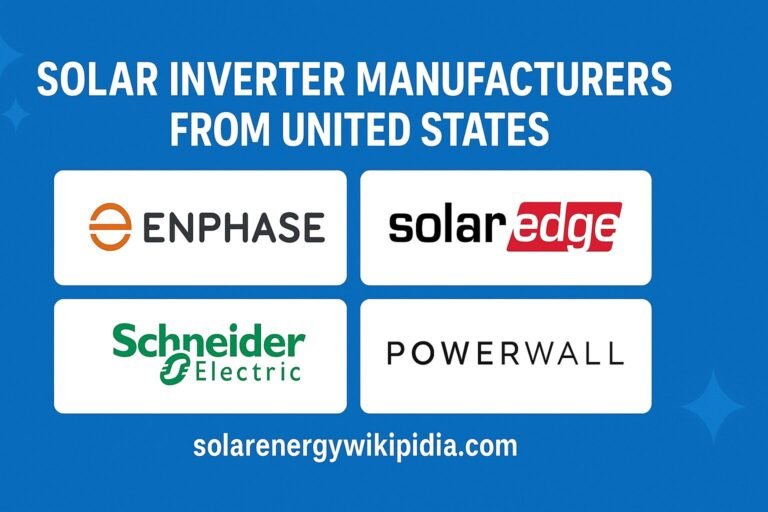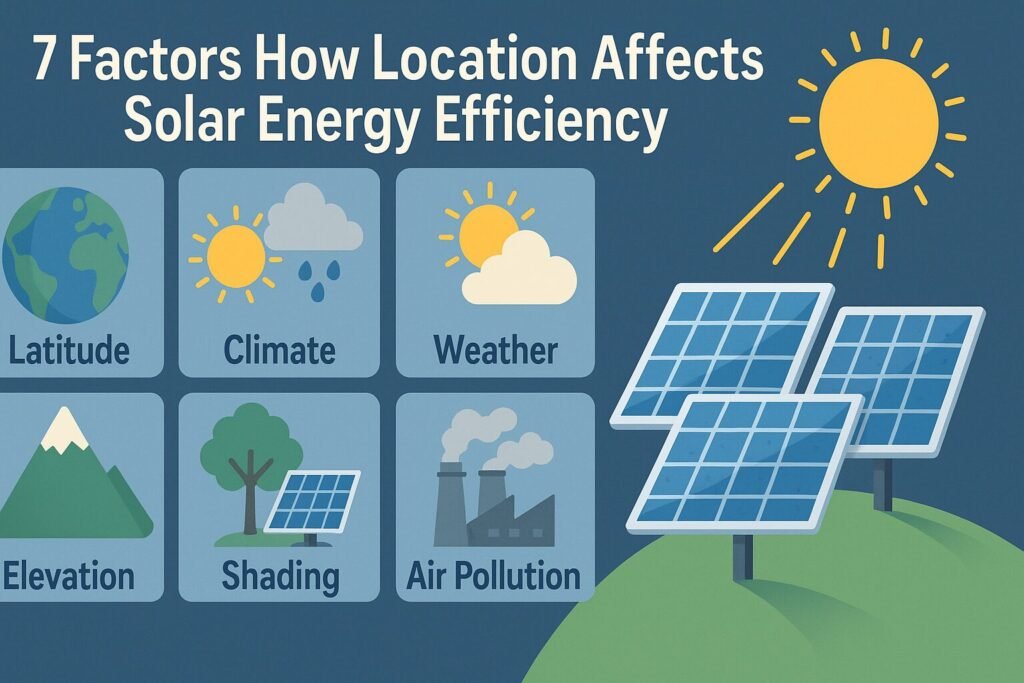
Discover the 7 crucial factors how location affects solar energy efficiency. Learn about sunlight hours, climate impact, and geographic advantages for maximum solar power generation.
Picture this: your neighbor installs the exact same solar panels as you, yet their electricity bill drops to nearly zero while yours barely budges. Frustrating, right?
The harsh truth is that location isn’t just important for solar energy—it’s absolutely everything. Where you live can dramatically boost your solar efficiency or completely sabotage your investment.
Let’s dive into the seven critical factors that determine whether your location is a solar goldmine or a costly mistake.
Table of Contents
Quick Reference: Solar Efficiency by Location Factors
| Location Factor | Impact Level | Efficiency Range | Best Conditions |
| Solar Irradiance | Very High | 15-25% variance | Southwest US regions |
| Latitude Position | High | 10-20% difference | 25-35° North/South |
| Climate Conditions | Medium-High | 12-18% impact | Dry, cool climates |
| Seasonal Variations | Medium | 8-15% fluctuation | Stable sun patterns |
| Geographic Features | Medium | 5-12% reduction | Flat, unobstructed land |
| Atmospheric Conditions | Medium | 7-14% loss | Low pollution areas |
| Altitude Effects | Low-Medium | 3-8% improvement | Higher elevations |
Data compiled from Solar Energy Research Institute studies and NREL databases.
The Sun’s Sweet Spot – Solar Irradiance Levels
Solar irradiance is like nature’s electricity meter—it measures how much solar energy hits your specific location.
Think of Arizona versus Alaska. Arizona receives nearly 2,500 hours of peak sunlight annually, while Alaska struggles with just 1,200 hours. That’s more than double the solar potential!
Peak Sun Hours Across America
The Southwest dominates the solar game. Nevada leads with an impressive 5.98 peak sun hours daily, followed closely by Arizona at 5.79 hours.
Meanwhile, states like Washington and Maine barely crack 3.5 hours. This massive difference explains why a 5kW system in Nevada generates 8,760 kWh yearly, while the same system in Maine produces only 5,200 kWh.
Real-World Impact on Your Bills
Here’s where it gets personal. A homeowner in Phoenix with a $150 monthly electric bill could potentially eliminate it entirely with solar. The same homeowner in Seattle might only reduce their bill by 60-70%.
Latitude: Your Geographic Destiny
Your distance from the equator plays a crucial role in determining how efficiently your solar panels perform.
The golden zone sits between 25-35 degrees latitude—covering states like Texas, Arizona, and Southern California. These regions receive optimal sun angles year-round.
The Angle Advantage
Solar panels work best when sunlight hits them perpendicularly. Locations closer to the equator maintain better sun angles throughout the year.
For instance, Miami (25.8°N) enjoys consistently high solar angles, while Minneapolis (44.9°N) experiences dramatic seasonal variations that can reduce winter efficiency by up to 40%.
Climate’s Hidden Impact on Solar Performance
Most people assume hotter climates always mean better solar performance. Surprisingly, that’s not entirely true.
Solar panels actually perform better in cooler temperatures with abundant sunshine. Germany, despite its northern location, has become a solar powerhouse thanks to its cool, bright climate.
Temperature vs. Efficiency Sweet Spot
Silicon solar panels lose approximately 0.4-0.5% efficiency for every degree Celsius above 25°C (77°F).
This means panels in Death Valley’s scorching 50°C heat operate at significantly reduced efficiency compared to those in Colorado’s crisp mountain air at the same irradiance level.
Humidity’s Sneaky Effect
High humidity creates atmospheric haze that filters sunlight before it reaches your panels. Coastal areas often experience 5-10% efficiency losses compared to arid inland locations at similar latitudes.
Seasonal Swings: When Location Determines Consistency
Solar energy production varies dramatically with seasons, and your location determines how wild these swings get.
Northern locations experience massive seasonal variations. Alaska sees summer days with 20+ hours of sunlight but winter days with barely 4 hours.
The Consistency Champion Locations
Southwest regions like Arizona and New Mexico offer the most consistent year-round production. Their winter output typically drops only 20-30% from summer peaks.
Compare this to northern states where winter production can plummet by 60-70% from summer highs.
Geographic Features: Nature’s Solar Blockers
Mountains, valleys, and urban landscapes can dramatically impact your solar potential.
Even small hills can create significant shade patterns that reduce panel efficiency by 15-25% during certain times of day.
Urban vs. Rural Solar Challenges
Cities present unique obstacles. Tall buildings create shade patterns, while air pollution reduces solar irradiance by 10-15% compared to rural areas.
However, urban areas often have better electrical grid connections and net metering programs that can offset these disadvantages.
Coastal Considerations
Coastal locations deal with salt air corrosion and frequent cloud cover from marine layers. These factors can reduce long-term panel performance and require more maintenance.
Atmospheric Clarity: The Invisible Efficiency Killer
Air quality directly impacts how much sunlight reaches your solar panels.
Polluted cities like Los Angeles can experience 20-25% reduced solar irradiance compared to clean air locations at the same latitude.
Dust and Particulate Problems
Desert locations face unique challenges with dust accumulation. While they enjoy excellent sun exposure, dust can reduce panel efficiency by 10-15% without regular cleaning.
Altitude Advantage: Higher Ground, Higher Efficiency
Every 1,000 feet of elevation increases solar irradiance by approximately 1-2% due to thinner atmosphere and reduced air pollution.
Mountain communities like Denver enjoy naturally higher solar efficiency than sea-level locations, even accounting for weather differences.
Making Your Location Work for You

Not blessed with Arizona’s perfect solar conditions? Don’t despair! Smart system design can maximize efficiency regardless of location.
Professional installers can optimize panel angles, choose appropriate technology, and design systems that work with your specific geographic challenges.
FAQs: 7 Factors how Location affects Solar Energy Efficiency Complete 2025 Tutorial
Q: Can solar panels work effectively in cloudy climates?
Absolutely! Germany generates substantial solar power despite frequent overcast conditions. Modern panels capture diffused sunlight efficiently, though direct sunlight always performs better.
Q: How much does location really affect my solar savings?
Location can impact savings by 200-300%. A system saving $2,000 annually in Arizona might only save $700 in a northern climate.
Q: Should I avoid solar if I don’t live in the Southwest?
Not necessarily. Many factors beyond location affect solar economics, including local electricity rates, incentives, and system costs.
Q: Do solar panels work better at higher altitudes?
Yes, higher elevations typically see 1-2% efficiency improvements per 1,000 feet due to cleaner, thinner air.
Q: How do I find my area’s solar potential?
Use tools like Google’s Project Sunroof or NREL’s PVWatts calculator to assess your specific location’s solar potential.
